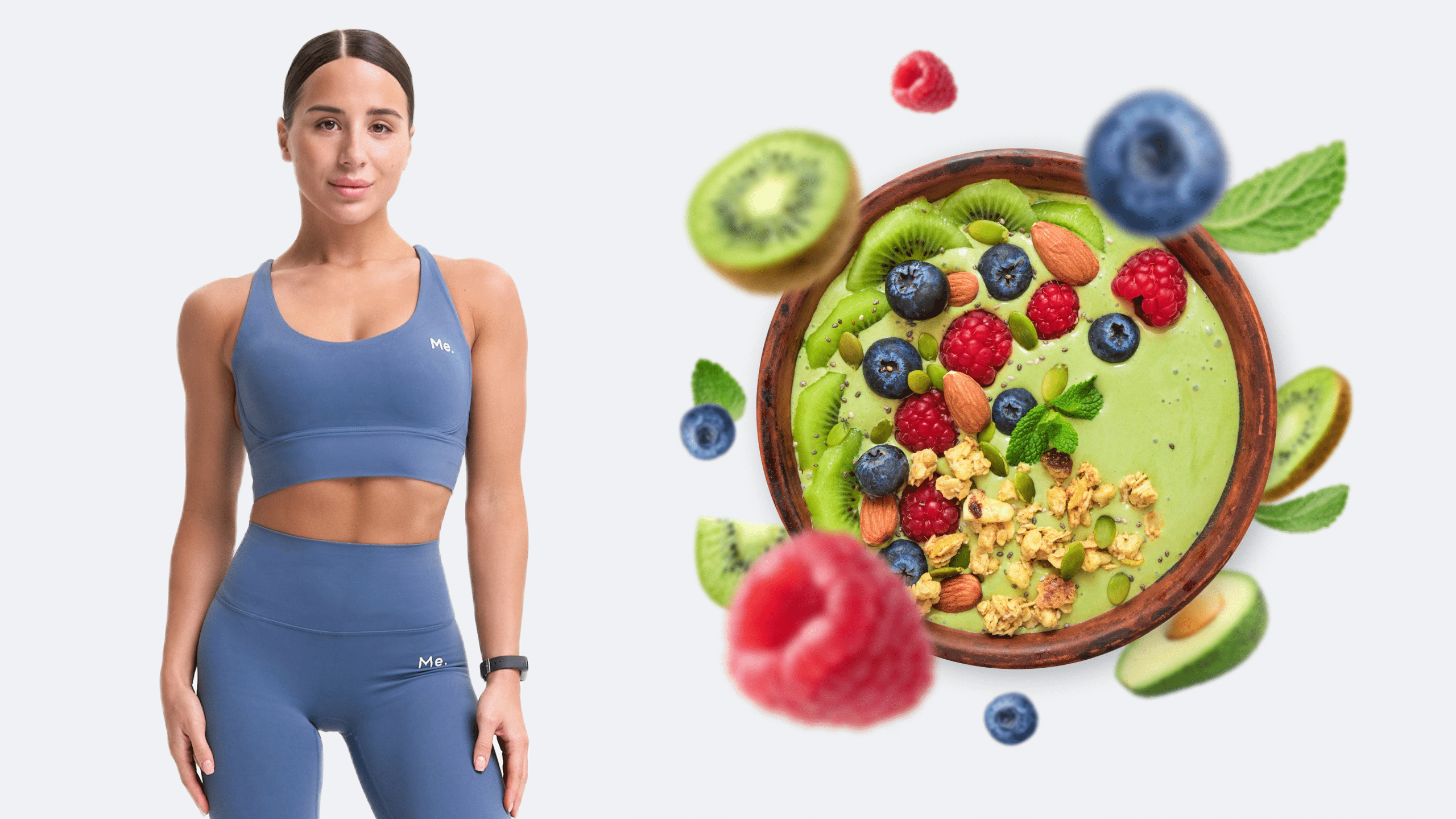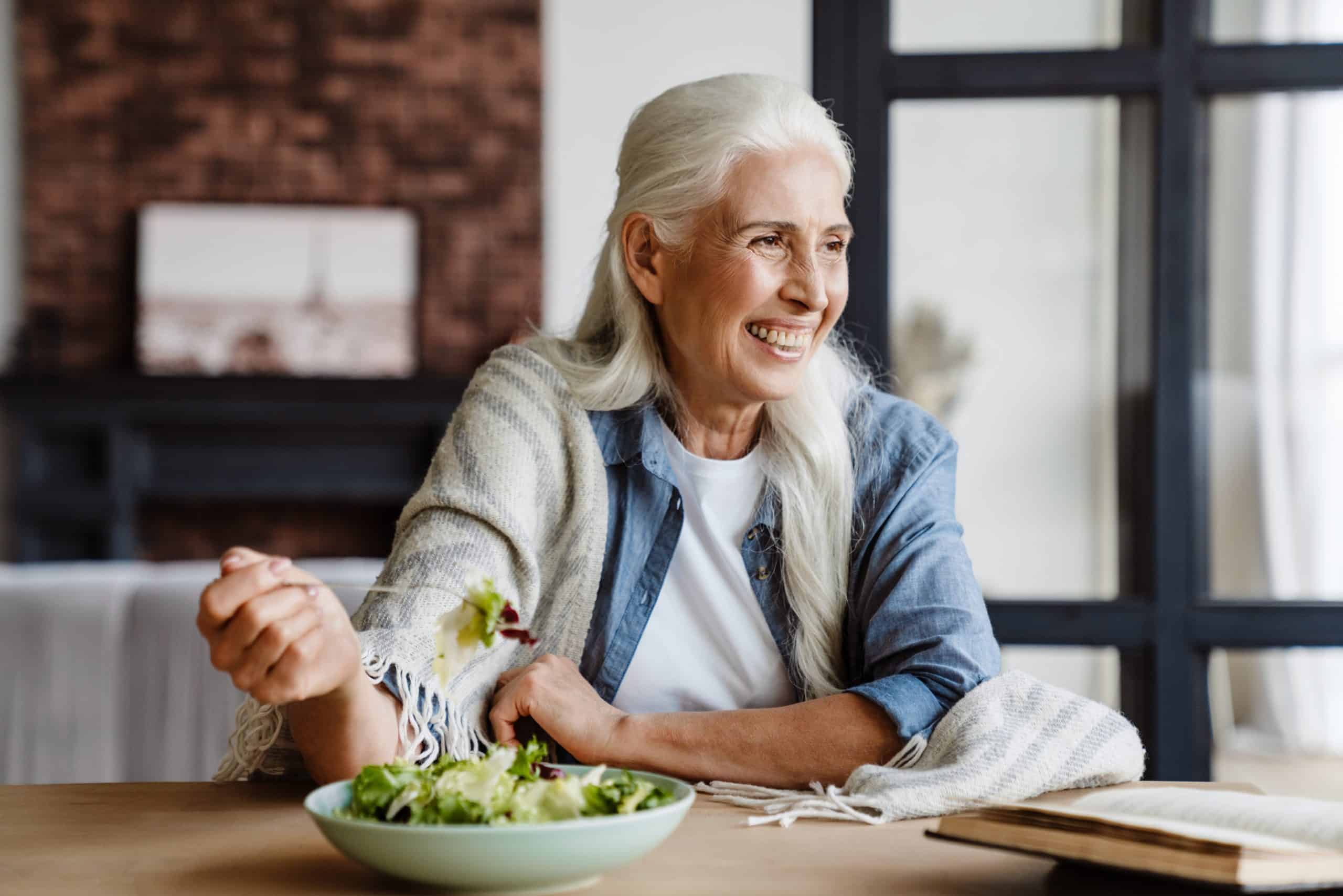Whether you’re new to dieting or not, you’ve probably heard the term “green smoothie” being thrown around as a part of a slimming diet. There are just as many versions of smoothie diets as there are recipes for this type of drink. However, the end goal is always the same – to lose weight by restricting your intake of other foods and creating a caloric deficit.
Before you get started with any diet, it’s always a good idea to find out whether it works from a scientific point of view.
What Is a Green Smoothie?
A green smoothie is simply a blend of fresh fruits and vegetables. In theory, you’re allowed to use any combination of these two ingredients to create a healthy version of the smoothie.
For example, an average green smoothie recipe may include 2 cups of spinach, 4 stalks of celery, 3 apples, and 1 cup of water.
The fruit will provide natural sugars (fructose) and fiber for a slower release and absorption of glucose into the bloodstream, which in turn makes you feel full for longer (16). The vegetables will supply antioxidants and other nutrients necessary to keep your body healthy (23). Smoothies also offer an excellent way of getting more fruits and vegetables, which offer a vast array of health benefits, in your daily diet.
In fact, one study found that people who consumed more fruits and vegetables experienced greater weight loss (11).
However, you should know that not every smoothie is as healthy as it could be. For example, there are frozen versions of smoothies in the grocery store with a high content of added sugars and high-fat dairy that can have health drawbacks if consumed in large quantities.
The smoothie diet is based on the principle that it will provide quick and sustained weight loss while keeping you feeling full for long hours of the day. It also promises to help detoxify your body by “flushing” away harmful toxins from the digestion process.
Are Smoothies Good for Weight Loss?
Technically, yes. If you replace high-calorie, excessively processed meals with green smoothies, then many health benefits are likely, including weight loss.
Weight Loss
As part of a balanced diet, smoothies can help you lose weight. However, these factors matter too:
- Smoothie ingredients – the likelihood of weight loss is dependent on the ingredients of a particular smoothie.
- Portion – the number of smoothies you consume in a day can influence the likelihood of weight gain or loss.
- Calories – some people add extra calories (such as nuts and seeds) to their smoothies, which due to their caloric density, may tip the caloric scale too much for fast and effective weight loss.
If you want to lose 1 pound in a week, then it’s important to know that the average adult requires approximately 2,000-2,500 calories per day, although there is significant individual variability (4). Many smoothie diets recommend a limit of 750 calories per day, which is a fraction of your daily caloric needs and consequently places the body in a large caloric deficit.
Keeping all of this in mind, if you create the perfect green smoothie with low sugar content, and add a few nuts or seeds to give it some texture, you’ll still be adding fewer calories than the smoothie diet allows. Therefore, this diet can be an effective way of maintaining your weight loss for a longer time period.
Looking for a way to break the vicious cycle of weight loss and tone up all the jiggly parts? Watch the extra pounds fly off and your muscles firm up with the BetterMe app!
Improved Digestive Health
Green smoothies are packed with fiber, which will help improve the health of your digestive system (19). Fiber comes in two forms – soluble and insoluble. Soluble fiber dissolves into a gel-like substance when it interacts with water. Therefore, it’s able to slow down digestion and cause you to feel full for longer periods of time (9).
Insoluble fiber doesn’t dissolve in water, so it moves through the digestive system pretty quickly. It’s responsible for bulking up your stool, which can prevent constipation (9).
Both types of fiber are found in high content in green smoothies, especially if you use leafy greens such as spinach and kale.
Stable Blood Sugar
Unlike juices, which are generally high in natural sugars, smoothies are known to have a slower release into the bloodstream. Therefore, they help keep your blood sugar levels stable.
This is particularly important for diabetics who may be prone to blood sugar spikes, which can cause them to feel very energized and sluggish at different times of the day (19). For everyone else, keeping your blood sugar stable is the best way to keep you energized for as long as possible.
Antioxidant Boost
Green smoothies are also known to be rich in antioxidants, which are responsible for the protection and repair of cells throughout your body. They help eliminate free radicals, which can lead to premature signs of aging (2).
What Can You Eat on a Smoothie Diet?
Depending on your body type and goals, the idea of drinking smoothies for weight loss may not be a good fit for you. However, they can definitely help speed up your weight loss process and offer certain other health benefits by adding fiber, antioxidants, and other nutrients to your diet.
Fruits
Apples, blueberries, bananas, mangoes, peaches – almost any fruit that is both sweet and in season will do. You can also use other fruits, but you should keep in mind that some may add extra calories to your smoothie, which could thwart your goal of weight loss.
Vegetables
Beets, cucumber, kale, melons – green smoothies are great because you can mix almost any vegetable into them. Leafy greens such as spinach and kale will help add to the fiber content in your beverage, which is good for weight loss and improved digestive health. Vegetables are also low-energy, dense foods (21).
Nuts/Seeds
Almonds, pecans, sunflower seeds – adding nuts and seeds to your smoothie gives it some texture and extra protein. This is particularly important as a source of protein, which helps promote satiety and build and repair tissues in the body, if you’re not including animal products in your diet.
Milks
Almond milk, coconut milk, soy milk – pick the one that best suits your taste preferences. Non-dairy milks can add additional nutrients to smoothies and make them creamier (12).
Some people may like using dairy milk, but it’s important to keep in mind that dairy milk is considered a processed food as it has been highly altered by refining and homogenizing.
Fats
Avocado and coconut oil are some of the best sources of healthy fats as they contain monounsaturated fatty acids (1). They can also be used for making smoothies creamier while boosting their nutritional profiles.
Read more: 24 Weight Loss Smoothies, 2 Diet Plans, and 5 Belly Fat Smoothie Secrets
How Much Weight Loss on a 30-Day Green Smoothie Diet?
A lot of people who have tried the smoothie diet claim to have lost between 5 and 20 pounds in a matter of weeks. However, it’s important to note that these numbers are based on testimonials, which don’t always represent the truth.
You should also be aware that any weight loss you experience from this diet will come down to your eating habits and exercise routine. Smoothies are not a magical potion – if you consume two smoothies per day plus a regular meal while still being sedentary and are not in a caloric deficit, you’re not going to lose weight.
It should also be noted that although smoothies can help you get a number of essential nutrients, the majority of smoothie recipes are still lacking when it comes to protein and fat. Therefore, it’s important to have a source of protein with your meal (animal or plant-based) so you can feel satiated throughout the day (g).
If you tend to let yourself off the hook, raise the white flag when things get tougher than you expected, send yourself on an unconscious binge-eating trip – BetterMe app is here to help you leave all of these sabotaging habits in the past!
Sample 30-Day Green Smoothie Diet Plan
To lose a significant amount of weight on this diet, you’ll have to take it beyond 30 days. It’s not recommended to follow the smoothie diet for a sustained period of time as limiting your meals to just smoothies will likely not provide you with sufficient amounts of protein, vitamins, and minerals that are found in whole foods.
Here’s how your menu for a day can look on this diet:
- Before breakfast: Start your day with a glass of warm water. You can add lemon slices for flavor.
- Breakfast: Green smoothie made with spinach, coconut milk, and fruits – you can add protein powder
- Lunch: Raspberry oatmeal smoothie made with low-fat Greek yogurt
- Dinner: Oven-baked salmon with steamed vegetables
- Snack: A handful of roasted nuts such as pecans or cashews
In addition to consuming a balanced diet, it’s equally important to make sure you get adequate physical activity. Staying consistently active is the key to a caloric deficit, weight loss, fat loss, and maintaining a healthy body (22).
Healthy snacking is a great way to stay full without adding empty or extra calories to your diet. Check out our blog, Salt-Free Snacks, for bite ideas that support your weight loss or healthy diet.
FAQs
Can I just drink smoothies instead of eating?
No, you shouldn’t just drink smoothies instead of eating whole foods. Relying solely on smoothies can lead to several nutritional deficiencies and health issues:
- Lack of dietary fiber: While smoothies contain fiber from fruits and vegetables, they lack the bulk you get from eating whole foods. Chewing on whole foods promotes better digestion and satiety (8).
- Protein deficiency: Most smoothies are low in protein unless specific ingredients such as protein powder or Greek yogurt are added. An insufficient intake of protein can impact muscle health and overall body function and reduce feelings of satiety (7).
- Healthy fats inadequacy: Smoothies often lack adequate healthy fats, which are essential for hormone production, brain health, and absorption of fat-soluble vitamins (A, D, E, and K) (18).
- Blood sugar spikes: Smoothies, particularly those with high glycemic foods and low protein and fat content, can cause rapid increases in blood sugar levels, which can lead to energy crashes and an increased risk of insulin resistance over time (6). Whole foods, on the other hand, often provide a more balanced release of energy.
- Satiety and enjoyment: Chewing and savoring whole foods contributes to feelings of fullness and enjoyment of meals, which is an important part of a balanced diet and psychological well-being (5).
- Digestive system impact: Whole foods provide necessary roughage that helps maintain a healthy gut. Smoothies often miss this aspect, which can lead to digestive issues such as constipation (9).
Therefore, while smoothies can be a nutritious part of your diet, they should complement whole foods rather than replace them entirely. Balance and variety are the key to maintaining overall health and well-being. As a result, even a diet that focuses on smoothies should also involve chewable whole foods to support all areas of health.
Which smoothie is best for weight loss?
The best smoothie for weight loss is one that is low in calories, high in fiber, contains protein, and includes ingredients that boost metabolism and reduce appetite. Focus on combining nutrient-dense foods that support weight loss through various mechanisms.
- Spinach and Kale: Leafy greens such as spinach and kale are low in calories but high in fiber, which helps with digestion and keeps you feeling full for longer (20). They also contain important vitamins and minerals that support overall body function (24).
- Berries: Strawberries, blueberries, and raspberries are low in calories and high in antioxidants, which can help reduce inflammation and improve metabolic function (15). Their natural sweetness makes a smoothie delicious without the need for added sugars.
- Greek Yogurt: This adds creaminess and a good amount of protein to your smoothie. Protein is essential for muscle repair, keeping you satiated, and maintaining a healthy metabolism (14).
- Flaxseeds or Chia Seeds: Both are excellent sources of omega-3 fatty acids, fiber, and protein. The fiber content helps with digestion (20) and the protein helps maintain muscle mass during weight loss (13).
- Green Tea: Adding a cooled cup of green tea can enhance your smoothie’s metabolism-boosting properties due to its caffeine content and catechins, which have been shown to support fat loss (10).
- Avocado: Including half an avocado adds healthy fats that are essential for nutrient absorption and help keep you full (18). Avocado also provides a creamy texture and doesn’t overpower other flavors.
- Bananas: Although they are slightly higher in calories, bananas are an excellent source of potassium and provide natural sweetness. They also help with digestion and keep the gut healthy.
- Unsweetened Almond Milk: Low in calories and often fortified with vitamins, unsweetened almond milk is a great liquid base for a weight loss smoothie without adding unnecessary sugars.
Example Recipe:
- 1 handful spinach or kale
- ½ cup mixed berries
- ½ banana
- ½ cup Greek yogurt
- 1 tablespoon chia seeds
- ¼ avocado
- 1 cup unsweetened almond milk
- Optional: 1 cup cooled green tea in place of almond milk
Blend all the ingredients together until smooth. This combination provides a balanced intake of macronutrients and micronutrients, supporting weight loss by keeping you full, energized, and satisfied.
Can a smoothie be a balanced meal?
A smoothie can be a balanced meal if it contains all the necessary macronutrients (carbohydrates, protein, and fat) and micronutrients (vitamins and minerals) (3), although many smoothies don’t contain all of these components.
For a smoothie to be considered a complete meal, it should provide 300-500 calories and include ingredients that support satiety, energy levels, and overall health. Some examples of balanced smoothie ingredients include:
- Fruits and Vegetables: They provide necessary vitamins, minerals, and fiber.
- Protein Sources: Greek yogurt, protein powder, or cottage cheese are excellent sources of protein to keep you feeling full and support muscle health.
- Healthy Fats: Avocado, nuts, seeds, or nut butter can add healthy fats and keep you satisfied.
- Liquid Base: Unsweetened almond milk, coconut water, or plain water are excellent options to blend your smoothie together. Avoid adding juice or sweetened dairy products as they can add unnecessary sugars and calories.
Overall, a balanced smoothie should provide a good mix of nutrients and provide enough calories to keep you feeling full and energized until your next meal. It should not be used as a replacement for all meals, but rather as a convenient and nutritious option when time is limited or you’re on the go.
So, make sure to include nutrient-dense ingredients in your smoothies to support overall health and well-being. Happy blending!
What is the healthiest thing to put in a smoothie?
The healthiest thing to put in a smoothie is a mix of nutrient-dense whole foods that provide a good balance of macronutrients (carbohydrates, protein, and fat) and micronutrients (vitamins and minerals). These ingredients provide essential nutrients for the body to function optimally and support overall health and well-being (3).
Explore the functions of the 4 Macronutrients and in what quantities to include them in your meals in greater detail in our previous blog post.
Is it healthy to drink smoothies every day?
Drinking smoothies every day can be healthy if:
- The smoothie is made with whole, nutritious ingredients such as fruits, vegetables, protein sources, and healthy fats, or is complemented with other foods that contain these components.
- The smoothie provides a good balance of macronutrients (carbohydrates, protein, and fat) and micronutrients (vitamins and minerals).
- It is not being used as a meal replacement for all meals. It should be consumed as part of a healthy and well-balanced diet.
- It is not being used to consume excessive amounts of sugar. Avoid adding juice, sweetened dairy products, or too many high-sugar fruits to your smoothie.
- It is not causing any discomfort or digestive issues. Some people may experience bloating or other digestive issues when consuming smoothies every day, potentially due to high fiber and fluid volume, so it’s important to listen to your body and adjust accordingly.
While eating a well-balanced meal is important to maintain a healthy weight, the quantities of food you eat also matter. Find out more in our blog, Eating Too Much Healthy Food: Can Good Nutrition Cause Weight Gain?
The Bottom Line
The 30-day smoothie diet can be a great way to kickstart both healthier eating habits and your weight loss journey. By following some simple tips and precautions, you can successfully complete the 30 days and reap the many benefits of this program.
Remember, smoothies alone can never replace a well-rounded and balanced diet, so make sure you continue making healthy food choices even after you’ve completed the 30 days.
DISCLAIMER:
This article is intended for general informational purposes only and does not serve to address individual circumstances. It is not a substitute for professional advice or help and should not be relied on for making any kind of decision-making. Any action taken as a direct or indirect result of the information in this article is entirely at your own risk and is your sole responsibility.
BetterMe, its content staff, and its medical advisors accept no responsibility for inaccuracies, errors, misstatements, inconsistencies, or omissions and specifically disclaim any liability, loss or risk, personal, professional or otherwise, which may be incurred as a consequence, directly or indirectly, of the use and/or application of any content.
You should always seek the advice of your physician or other qualified health provider with any questions you may have regarding a medical condition or your specific situation. Never disregard professional medical advice or delay seeking it because of BetterMe content. If you suspect or think you may have a medical emergency, call your doctor.
SOURCES:
- A healthy approach to dietary fats: understanding the science and taking action to reduce consumer confusion (2017, ncbi.nlm.nih.gov)
- Antioxidants: In Depth (2013, nccih.nih.gov)
- Biochemistry, Nutrients (2023, ncbi.nlm.nih.gov)
- Calories (2020, ncbi.nlm.nih.gov)
- Can eating pleasure be a lever for healthy eating? A systematic scoping review of eating pleasure and its links with dietary behaviors and health (2020, ncbi.nlm.nih.gov)
- Carbohydrates and Blood Sugar (n.d., nutritionsource.hsph.harvard.edu)
- Dietary Protein and Muscle Mass: Translating Science to Application and Health Benefit (2019, ncbi.nlm.nih.gov)
- Effects of chewing on appetite, food intake and gut hormones: A systematic review and meta-analysis (2015, sciencedirect.com)
- Fiber (n.d, hsph.harvard.edu)
- Green tea catechins, caffeine and body-weight regulation (2010, pubmed.ncbi.nlm.nih.gov)
- High intake of fruits and vegetables predicts weight loss in Brazilian overweight adults (2008, pubmed.ncbi.nlm.nih.gov)
- International Analysis of the Nutritional Content and a Review of Health Benefits of Non-Dairy Plant-Based Beverages (2021, mdpi.com)
- Preserving Healthy Muscle during Weight Loss (2017, sciencedirect.com)
- Protein, weight management, and satiety (2008, academic.oup.com)
- Review of Functional and Pharmacological Activities of Berries (2021, ncbi.nlm.nih.gov)
- Sugar: fruit fructose is still healthy (2012, nature.com)
- Sugars and blood glucose control (1995, academic.oup.com)
- The Functions of Fats – Nutrition: Science and Everyday Application (n.d., openoregon.pressbooks.pub)
- The health benefits of dietary fiber: beyond the usual suspects of type 2 diabetes, cardiovascular disease and colon cancer (2012, ncbi.nlm.nih.gov)
- The Health Benefits of Dietary Fibre (2020, ncbi.nlm.nih.gov)
- The Relationship between Vegetable Intake and Weight Outcomes: A Systematic Review of Cohort Studies (2018, ncbi.nlm.nih.gov)
- The Role of Exercise and Physical Activity in Weight Loss and Maintenance (2015, ncbi.nlm.nih.gov)
- Vegetables as Sources of Antioxidants (2013, researchgate.net)
- Vitamins and Minerals: Types, Sources and their Functions (2020, researchgate.net)













